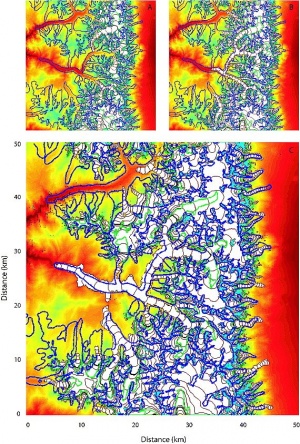Model:Gc2d
Gc2d
Metadata
|
|
|
Introduction
gc2d a two-dimensional finite difference numerical model that simulates the formation and evolution of temperate valley glaciers on a two-dimensional topographic surface with a specified meteorological setting. Driven by a time series of mass balance (snow precipitation - melt rate), the model calculates ice surface elevations above a two-dimensional terrain by solving equations for ice flux and mass conservation using explicit methods. A number of other authors have employed one- and two-dimensional models based on similar sets of equations. However, gc2d integrates glacier and climate simulation components explicitly, and thus has the unique ability to simulate feedbacks between the changing ice surface and the climate forcing. In addition, the framework of this model permits the inclusion of discrete processes that modify the ice distribution, such as avalanching on steep terrain. The efficiency of this model allows simulation of glacial evolution over millennial timescales at spatial scales that resolve valley glaciers. Finally, from a computational standpoint, the simplicity of this model permits the investigation of significant regions of parameter space, allowing us to determine the effect of new processes or altered algorithms for them.
The above description is taken almost verbatim from Kessler et al. (2006).
References
| Nr. of publications: | 4 |
| Total citations: | 455 |
| h-index: | 4 |
| m-quotient: | 0.17 |
| Featured publication(s) | Year | Model described | Type of Reference | Citations |
|---|---|---|---|---|
|
MacGregor, K.R.; Anderson, R.S.; Anderson, S.P.; Waddington, E.D.; 2000. Numerical Simulations of Glacial-Valley Longitudinal Profile Evolution.. Geology, 28, 1031-1034. <1031:NSOGLP>2.0.CO;2 10.1130/0091-7613(2000)28<1031:NSOGLP>2.0.CO;2 (View/edit entry) | 2000 | Gc2d |
Model overview | 192 |
| See more publications of Gc2d |


